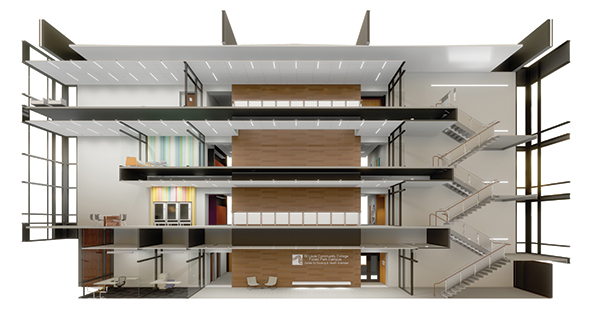
By Joshua Phelps
The Scene staff
Construction is moving along on the new $39 million Center for Nursing and Health Sciences building at Forest Park, and the contractor expects work to be completed in July.
That means St. Louis Community College students in health-related fields will be taking classes in the building this fall.
“We’re real excited about it,” said nursing professor Lisa Moreland. “Our students have needed some new, updated laboratory space and simulation space for quite a while.”
No more classes will be held in A and B towers after spring semester, according to Paul Zinck, vice chancellor of finance and administration for STLCC. Those in non-health-related subjects will be redistributed around campus.
Zinck said the college plans to demolish the two four-story brick towers by late 2020.
“What should happen next fall is we will begin the process of salvage,” he said. “So we’ll try to take anything out of the buildings that we can reutilize elsewhere, and then we will start the process of abatement of materials that need to be abated from the building.”
The 96,000-square-foot Center for Nursing and Health Sciences building will be four stories, mostly glass with brick accents. It’s being built north of A Tower and west of the physical education building.
The new building will house modern classrooms, laboratories and offices for nursing, dental hygiene and eight other health-related programs.

“The first floor will have the dental hygiene program and the dental clinic,” Zinck said. “The second floor will have much of the nursing program, so that will include a nursing skills lab. It’ll also have the respiratory care program from Forest Park.”
The second and third floors will provide space for general classrooms and computer labs. The surgical technology, radiology support and EMT paramedic programs will be headquartered on the third floor.
The college’s original plan included office space for STLCC Chancellor Jeff Pittman and other district employees on the fourth floor, but that has changed.
“Floors one through three will be completely finished, and then the fourth floor will just have unfinished space for development at a later time,” Zinck said.
The college will stay within the $39 million budget originally planned for the project, he added.
The Center for Nursing and Health Sciences building is being constructed by Tarlton Corp., a private contractor based in St. Louis. Senior Project Manager Andrew Nelch expects it to be completed by July 15.
“Right now, on the outside of the building, we’re working on installing glass,” he said. “We’re working on closing all the storm-front windows, and we have another shipment of glass for the two elevations that won’t come until the beginning of April.”
Workers also are preparing to install steel panels in between glass on the outside.
Inside, the company is making progress with drywall and taping on the first, second and third floors, Nelch said. Painting is underway on the second and third floors.

“Once that moves along a little farther, we’ll start wrapping up things like lights, things to get ready for ceilings to start,” Nelch said. “It’s going well, but the weather makes it tricky at times.”
The college has begun ordering equipment and furnishings for the new building, Zinck said.
Faculty members now teaching in A and B towers will have to move after spring semester. That includes statistics professor Judy Clark, whose statistics class will go from the third floor of A Tower to the third floor of E tower.
Clark isn’t happy about relocating, but she sees the new building as an opportunity for the college to grow and attract more students.
“It’s good for the city (and) for the students who are considering a program in allied health,” she said.
Moreland is particularly happy that her nursing students won’t have to do lab work on the fourth floor of C Tower and attend lectures in the basement once the new building opens.
Students also are excited about getting new digs.
“I think it’s good,” said nursing major Danielle Warren, 20. “I think this building will allow us to hold a lot more students, and (they can) get their associate’s degree faster.”
